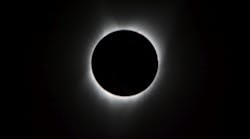From the beginning of August 2017 until it happened, the main topic of conversation in North America had been the total solar eclipse. It really captured everyone’s attention because it was something different from normal daily life. The total eclipse was going to take a path through the United States from Pacific Coast to the Atlantic Coast. It would only last a few minutes for the viewers, but from start to finish there would be a couple of hours of varying degrees of darkness across a large swath of the continent. The most interesting thing about the hype was the predictions coming from a variety of experts. Most were pretty mundane conjecturing about how it would affect people and animals, but the predictions that got my attention were about the impact it would have on the North American power grid.
Experts had a field day speculating on the effect this solar eclipse would have on the solar generation connected to the power grid. Many said it would seriously impact our grid because of the large amount of solar generation feeding electricity into the electricity system. I saw several TV news stories envisioning the eclipse wiping out gigawatts (GW) of power. One group prophesied solar generation would decrease to less than 50% of capacity nationwide and the voltage swings would make the grid unstable to the point of collapse – talk about far out in left field. Currently there is about 42.6-GW of solar generation connected to the U.S. grid, which is only about 5% of the U.S. peak demand, but then reality isn’t good for speculation.
It reminded me of the hysteria associated with Y2K, better known as the Millennium bug. Everyone thought the world was going to end on New Year’s Eve when the clock struck midnight and we moved from 1999 to 2000. Networks were going to fail because computers read the year using the last two digits of the year. The soothsayers were convinced that when we entered 2000 the computer operating systems would think it was 1900 and the power grid would crash. Engineers came up with patches for the software, which were tested and installed, but to the non-technical population there was still a great deal of fear and anxiety. When the big moment came, it was a non-event and life went on.
The same thing happened with this year’s total solar eclipse. One news source reported the effect on the power grid turned out to be a big yawn for the North American power grid. But there is still the need to be cautious in the future. As solar generation increases worldwide, countermeasures are needed for times when the sun isn’t shining such as cloudy days, stormy days, and yes, solar eclipses. NERC produced a white paper on understanding the eclipse phenomena, which can be downloaded at http://www.nerc.com/news/pages/august-solar-eclipse-not-expected-to-impact-bulk-power-system.aspx.
With the 2017 eclipse we have seen the preparations the utilities made were more than adequate for the effects on the grid. We should also consider the investment that utilities are making in smart grid technologies, which had an impact on the varying reductions in solar generation and voltage swings associated with them. Energy storage plays an important part in improving the output variable normally found in the wind and solar resources. Volt/VAR controllers have also been improving the optimization needed to manage voltage swings and reactive power for a power delivery system with increasing renewable generation on both the transmission and distribution systems. HVDC transmission is delivering electricity to load centers independent of what is taking place on the AC grid. Improved FACTS technology has proven a key tool for load support in weak parts of the grid.
In addition to these digital technologies, we have also been installing fast response gas turbines for rapid generation to support the variability associated with wind and solar. The game-plan has these speedy gas turbines combined with state-of-the-art digital technologies to smooth out those instabilities. It’s no wonder the 2017 total solar eclipse was just another manageable variable for the industry to handle as we provide our customers with reliable power on a daily basis. As character actor Walter Brennan was fond of saying, “No brag, just fact.”


